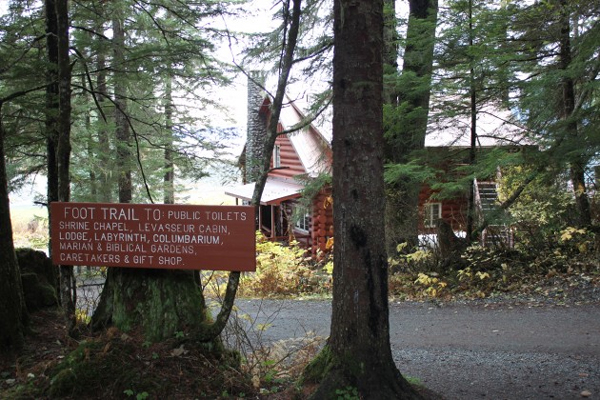
The Shrine of St. Therese kicked off a year-long 75th anniversary celebration on Saturday. The cornerstone of the chapel was laid and blessed by Alaska Bishop Joseph Crimont on October 30, 1938.
The Shrine was originally built as a place to inspire devotion to God. At the time, there were no other spiritual retreat houses in Alaska and Father William LeVasseur saw the need to build one.
But throughout its 75 year life, the Shrine has welcomed people of all beliefs. Residents of Juneau, Southeast Alaskans, and visitors go to the Shrine for all kinds of reasons.
As you drive out Glacier Highway from downtown Juneau, you eventually start winding along the coast with intermittent views of the Chilkat Mountains. Past Tee Harbor, you start driving up. Soon, you descend through a hemlock forest.
Turn left at mile 23 and find “a lot of trees, streams. As you walk down, you see log structures, you see the ocean,” describes Thomas Fitterer, director of the Shrine of St. Therese for almost 25 years. “You see a causeway. On the other side of the causeway is an island, Shrine Island. So you walk over to Shrine Island and suddenly you see a church made out of rock.”
Surrounding the church are the Stations of the Cross, each station depicting a scene of Christ’s final hours on earth and the resurrection.
“Then you look out and the ocean waves are hitting against the rocks, so you have God and nature so prevalent there that you cannot help but be influenced – whether you’re a believer or non-believer – somehow or another, one is touched by the peace, by the gift of natural beauty, and by the spirit,” Fitterer says.
From the beginning, the Shrine has been a place where everyone is welcome, even in the 1940s, Fitterer says, when religious groups tended to stay separate.
“Back then even, people of all denominations or no denomination felt comfortable coming to the Shrine and that’s been the flavor ever since and that’s something that I would never want to see lost,” he says.
The Shrine was built as a place to hold religious retreats, escape normal activities and be with God through prayer and reflection. It’s still a place to retreat, but in many different ways.
“The good thing about the Shrine,” Fitterer says, “is you can do everything from have a picnic on the beach to fish to rock climb to rock find to walk the labyrinth. It fulfills the needs of so many people in so many ways.”
The Shrine has always been seen as a place to escape this busy world full of distractions. “You’ve got your iPhone and you’ve got your tweets and you’ve got whatever else, a lot of people just get caught up into that pattern,” says Fitterer.
Over the years, visitors have told Fitterer about how much they enjoy being at the Shrine. People have talked of experiencing miracles and feeling close to God, even when they didn’t have one.
Fitterer recalls one visitor who have traveled all over the world, but felt a special presence at the Shrine, “She just could feel it, and she said I’ve never seen and felt a more beautiful place on earth.”
At the Shrine, volunteer Sam Bertoni walks to the outdoor columbarium where the ashes of his mother and another 200 individuals are laid to rest.
“Some people come and visit all the time,” says Bertoni. “I know people that come out here on a regular basis every week to put flowers or to communicate with their loved ones. Some folks come out here many times a week.”
A semi-circle of six black granite walls, each about seven feet tall and 11 feet long face the ocean.
“And it’s a fantastic view. You know I can’t afford beachfront in this life, but maybe in the next life,” Bertoni laughs.
The Shrine offers church services during the summer and other holidays throughout the year. Bertoni remembers one Easter service. “There must have been 100 people and there must have been 150 sea lions out here yelping because of the killer whales, and there was so much commotion, you couldn’t even talk. It was like a hundred dogs barking. It was really something,” Bertoni says.
Over the decades, the Shrine has grown beyond the original structures of the chapel, lodge, caretaker’s house, and the post office. It now offers five separate rental cabins which are used regularly for day use, overnights, weekends, and longer stays.
Caretakers Jack and Jeanne Jordan are in charge of the daily happenings at the Shrine. Besides being used by the Catholic Diocese of Juneau, the units are rented out by many other groups.
“We have other churches, the state of Alaska, the school district, the Coast Guard, different businesses utilize it, we have yoga groups sometimes, women’s retreats and sewing groups, scrapbooking groups, anniversary celebrations, birthday celebrations, family reunions,” says Jeanne Jordan.
It could be as simple as wanting a quiet place to walk around or as complicated as pondering the meaning of life. Jordan says people in search of something often visit the Shrine of St. Therese and find what they’re looking for.
Lisa Phu is a reporter at KTOO in Juneau.




